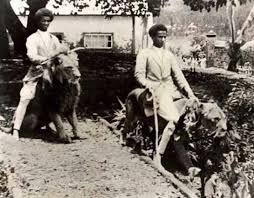Continued from Part 1
Ethiopian forces under the leadership of Emperor Menelik II surprised the world by defeating an Italian Army sent to conquer the Empire.
The Imperial Army included troops raised by governors-general, such as Ras Makonnen (the father of Ras Tafari Makonnen, later Emperor Haile Selassie I) who commanded some 12,000 troops. Dejazmatch Tesema commanded some 5,000 soldiers; Ras Welde Giorgis about 5,000; Ras Bitwoded Mengesha Atakim, about 6,000; and so on. Troops of the regional princes numbered about 35,000, and of these, Ras Mengesha of Tigré commanded about 8,000; King (Negus) Tekle Haimanot of Gojjam about 6,000; Ras Welle of Begémder another 6,000; Wagshum Guangul of Wag a further 5,000.
Emperor Menelik took immediate steps upon hearing of Italy’s plans to annex Ethiopia. He called, on September 17, 1895, for national mobilization, and within two months more than 100,000 troops were assembled in the specified areas: Addis Ababa, Were Illu, Ashenge, and Mekele. About two-thirds of these troops were raised through the Geber Madriya system. The Emperor himself mobilized some 35,000 troops, commanded by his court officials. His Queen — Empress Taitu — also mobilised her own force of some 6,000 men.

The Treaty of Wuchale
Italy and Ethiopia’s Emperor Menelik II agreed to terms in the Treaty of Wuchale in May 1889. Amharic and Italian were used to draft the agreement. This treaty eventually led to the Adwa war. To Menelik’s dismay, he found out that the two treaty texts used different terminology. In contrast to the Amharic version, the Italian one made Ethiopia an Italian protectorate.
On September 17, 1895, Menelik called for all troops to prepare for war with Italy. He told all Ethiopians to stand up for their country, their families, and their religions. The Conversation states that Menelik told everyone who could fight to do so and told those who couldn’t to pray for Ethiopia to win.
The New Times says that when Ethiopia won at Adwa, it was a big turning point that showed both Europeans and Africans that colonial conquest was not inevitable. There were some small protests in Italy against colonialism as a whole, but they were met with a larger call for revenge.
The modern parallel to the situation came with the Israeli-Egyptian confrontations of 1967 and 1973. The Israeli victory in 1967 (the Six-Day War) left Israel complacent and confident in the superiority of its forces over those of the Egyptians. Apart from this, the Israelis had put in place the Bar-Lev Line of fortifications, which were expected to hold against any conceivable Egyptian attack. But the Israeli leadership and intelligence services failed to note that the crushing defeat inflicted on Egypt so quickly in 1967 had brought about a dramatic transformation in the psyche of the Egyptian leadership. President Anwar as-Sadat totally transformed the education, training, equipment and doctrine of the Egyptian Armed Forces, without Soviet help (Soviet advisors had been expelled in 1972), within six years of the defeat. When Egypt initiated the October 1973 war, the transformed situation took Israel by complete surprise. Despite the massive logistical re-supply of Israel by the US — which effectively saved Israel from complete humiliation — and the recovery of initiative by Israeli commanders, Egypt achieved its strategic objectives. The Suez Canal was re-opened, the Sinai returned to Egypt, and peace achieved.
Apart from the overall political and social aspects of Ethiopia in 1868, Emperor Téwodros had based his defence against the British on the Rist-Gult system of recruitment, military structure and logistical support. This logistical structure was entrenched in what was commonly called Mesfint Hagr: namely, the present-day highlands of Eritrea, the region of Tigré, Gonder, Gojjam, and Wello. The rest of Ethiopia was under a second type of resource system known as the Geber Madriya system, which formed the basis of the fiscal and military organization of Emperor Menelik’s Government.
But much had happened since Magdàla, and Emperor Téwodros’ defeat. Indeed, the British victory had even at that time obscured from General Robert Napier and his officers the sophistication of the system which they had just defeated. Victory often breeds contempt in the victors against the vanquished; at best it breeds an unwillingness to learn from the enemy so recently crushed. The Rist-Gult system was used not only at Magdàla, but also against Egypt at Gundet (1875), Gura (1876), Italy at Dogali (1887), and against the Mahdist Sudan at Metemma (1889). [It was in this battle, at Metemma, that Emperor Yohannes IV had died.] The Battle of Adwa was based mostly on the Geber Madriya system.

Ethiopian historian Tsegaye Tegenu noted that in all of these large battles, the background composition of the troops were similar. “All were drawn from the various ethnic groups and constituted the class of military nobility, regional aristocracy and peasantry. However, there was a difference in the manner of administration and the use of human and material resources [at Adwa]. The troops of Adwa were recruited basically through the Geber Madriya system, which had qualitatively different methods of remuneration, revenue administration and provisioning, which was in harmony with the form of economy.”
One of the major failings of the Italian planners of Savoyard Italy was that they failed to notice the fundamental change in Ethiopia under Menelik. Emperor Menelik II had transformed the administration of the economy and had greatly improved the tax base of the country. This in turn improved dramatically his capability to raise armies and to equip them.
The complex tax base meant that the battles fought during the era of the Rist-Gult system were precariously-managed affairs. As Tsegaye Tegenu noted: “It is not difficult to see the desperate effort of the kings to overcome the fiscal limits of the system to fight against external aggression.” And Menelik managed this transformation to a new economic base in such a way as to prepare Ethiopia for the most decisive battle.
Stay tuned to our website www.globalafricantimes.com for the continuation of this African History Discovery Series on the Ethiopians and the Battle of Adwa
Additional Sources: The Battle of Adwa: African Victory in the Age of Empire, Emmanuel Kwarteng – Face2Face Africa, Reuters, Brittanica




